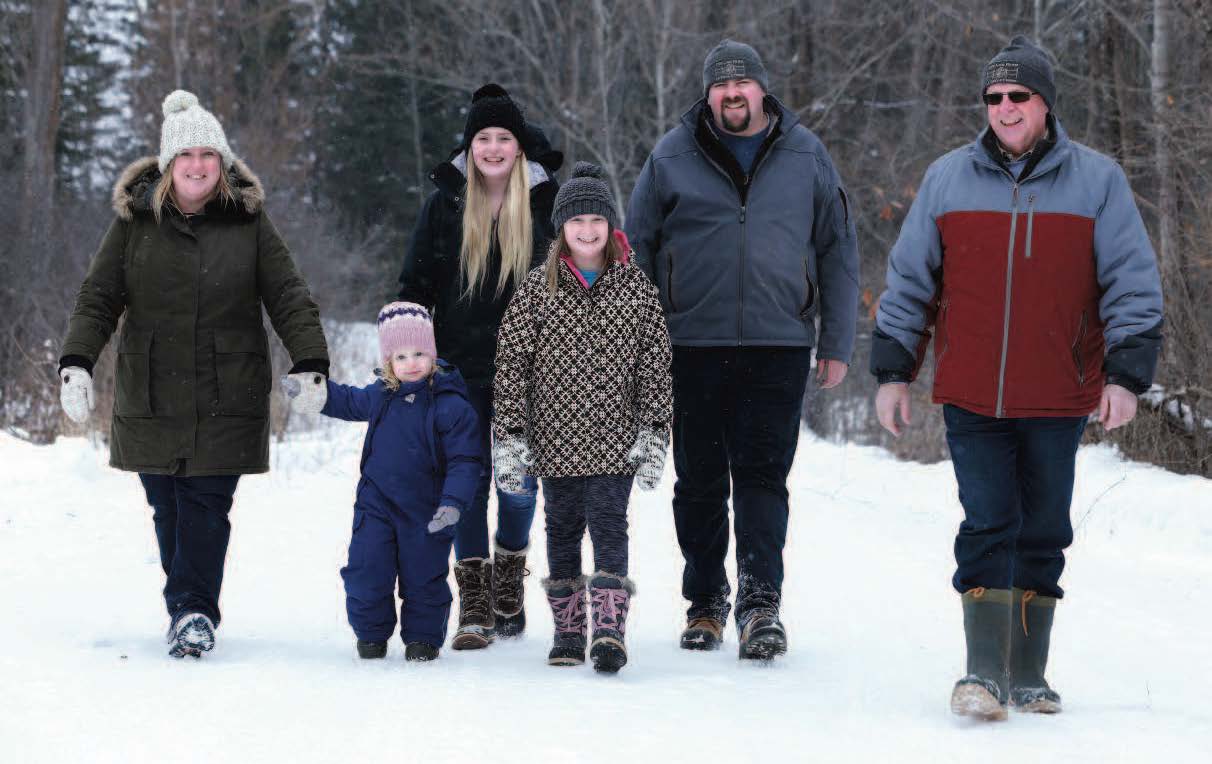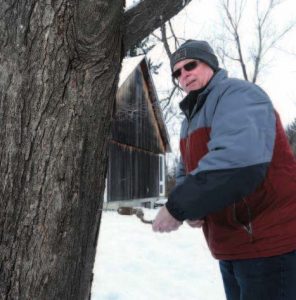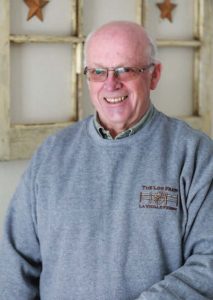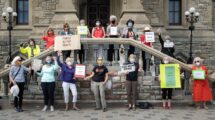
By Car0line Wissing, Photos by John Major
Three generations of one family open a window into pioneer life
What would life have been like as a pioneer in the Ottawa Valley? Imagine the heat and drought of summer; the time, energy and work during autumn; the bitter cold of a long winter, including keeping animals warm and fed; and finally, the renewal of spring.
It’s not everyone’s dream to help run a farm using pioneering techniques, but for the Orr family’s patriarch Larry and his wife Karen, it’s a dream come true.
At The Log Farm, you can get a view of that pioneer life right in the heart of the city. Located at 670 Cedarview Road, it’s an easy drive from most places in the centre, south or west of the city. And it’s not too far from the east end either. Of the location, Larry says, “There are a half a million people within fifteen minutes of here.”
The Orr family acquired the site in May of 2016 and, for the first time in more than 25 years, three generations of family are now working the farm. Larry and Karen drive in from Kars to help out, while their son Ryan, Ryan’s wife Amy, and their three children, Maddy, 14, Marissa, 12, and Sadie, four, live on the property.
The main draw for visitors is The Log Farm’s history. In the 1800s, Abraham Bradley emigrated from Ireland with his parents, who came to Ottawa to work on the canal. As Ryan explains, “With the land-grant program, he applied and got his hundred-acre piece, which was this farm here.” Abraham married his wife, Matilda, they built a house, and together they raised nine children on the farm.
The property changed hands a number of times over the decades, and in 1966 the National Capital Commission (NCC) expropriated the land for the Greenbelt project. Because of its location and the original buildings, the NCC later decided to run it as a historical farm site. In 2015, the NCC sent out a call to farmers who could be long-term tenants on several of their Greenbelt properties, including the Cedarview Road property, and who would develop these farms using sustainable agricultural practices.
Right away, Larry and Ryan were interested. Both of them had volunteered on The Log Farm in the late 1990s and had felt a connection to the property ever since. Ryan says of his motivation to run The Log Farm, “It’s a unique piece that could be a mix where I could farm and be open to the public.”
Larry and Ryan discussed the idea. “We decided it was kind of a nice fit, to make it a family project,” says Larry. So, father and son worked together to create a proposal that included some innovative ideas for re-engaging local interest in this unique property. “There was no sense in doing what everybody else had tried to do and had failed,” Larry explains. “We wanted to turn it into an actual farm, as opposed to just some buildings that are showcased. So that was fun.”

Although Larry grew up on a farm, he hadn’t been on a farm in years. So, Ryan and Amy do most of the farming, while Larry and Karen take on other tasks such as promoting the farm and working in the visitor centre and gift shop.
It has definitely turned into a family affair, with all family members—oldest to youngest—pitching-in to complete the chores, from feeding the chickens to working with the public. “From a selfish standpoint,” Larry says, “it was a great opportunity to spend a lot of time with our grandchildren, because they’re involved. They work as well.”
Ryan agrees, saying, “Maddy, the oldest one, works in the store quite a bit with her grandmother. She runs the cash and enjoys that.”
Aside from time with his grandkids, Larry says the historical aspect of the farm is of great interest to him. “I think it’s important that people see that,” he says, “because it’s disappearing so quickly. Even a small family farm just doesn’t exist anymore. There’s nowhere you can go and see a true functioning farm.”
Ryan, Amy and the kids live in a house on a private area of the farm. Their cozy living room provides a stunning view of the property courtesy of several large, bright windows. A crockpot burbles gently on the kitchen counter. It’s like any family home, except this family welcomes thousands of visitors a year to the public areas of their farm.
Amy says the farming part of their life at The Log Farm wasn’t scary or new; for her, working with the public was out of the ordinary. Keeping people happy, while reinforcing respect for the property, is a balancing act that Amy and Ryan are learning from season to season.
Over the past couple of years, the family has launched several initiatives that span the three seasons The Log Farm is open to the public. (It’s closed during the winter months).
Visitors can tour the historic barn and other outbuildings, and also get to know the various animals. The Orrs have acquired chickens, ducks, pigs, sheep, horses, cows, barn cats and a donkey. There’s no pony for the girls to ride yet, but Amy says, “It’s on their wish list.”
Beyond the barn and animals, a big attraction is the Bradley house itself. Built in the 1850s, it comes complete with period decorations and equipment, like a wood-burning stove in the kitchen. Somehow the house feels more spacious than its 800 square feet because of the unique soaring height of the ceilings. But it remains a marvel that the couple managed to raise such a large family in such a small home.
The first floor has a kitchen and sitting room with furniture typical of the time. The second story, added in 1861, has a loft-style main bedroom with doorways leading to two smaller bedrooms. During a tour of the house, Larry says the parents would have slept in the main bedroom, while one of the other rooms would have been for the boys, the other for the girls. A couple of wooden cradles from the period indicate that babies would likely have slept in the main bedroom with mom and dad.
In the spring, The Log Farm’s sugar bush offers both a great outing and a learning experience for anyone. There’s modern equipment on-site to produce the maple syrup that’s sold in the store of the visitor centre. The Orr family also has an area set up that allows visitors to see how pioneers boiled sap in a cast-iron cauldron over an open fire. Some of the maple trees have covered buckets that hang from the old-fashioned taps, and you can carry a pail of sap from the tree to the cauldron. You will quickly appreciate how much work making maple syrup used to be, and the enormous amount of sap that’s needed! “The whole concept that it takes 40 gallons of sap just to make one gallon of maple syrup just about floors most people,” Larry notes.
Another successful initiative is the farmers’ market the Orrs run on the property from May to October. The farmers’ market is Larry’s main project, and where he and Karen really put their skills and knowledge to work. “We thought it fit really well with the farm and what we’re trying to do in educating people about history and food,” Larry says of the idea to include a market. “For the last 18 years or so, my wife and myself have been involved with the North Gower farmers’ market. We know quite a bit about farmers’ markets, and this area certainly needed one.”

During the season, the market runs Saturdays from 9 a.m. until 2 p.m. and sells such local items as garlic, honey, meat, free-range fresh eggs, homemade preserves and hot sauces, seasonal fruits and vegetables, as well as crafts like jewelry and glassware. “What we tried to do was develop an authentic, original farmers’ market,” Larry says, “where you have people who are actually the producers of the product that’s being sold. But also surround that with other handmade items, not just food.”
Information about the market and current vendors is available at barrhavenfarmersmarket.com. For local farmers and crafters who are interested in becoming vendors at The Log Farm Farmers’ Market, drop them a line at: thelogfarm@rogers.com.
Additionally, Amy runs a playgroup program called Toddler Time. It’s for parents or grandparents and children under age six to explore and enjoy the property together. Each Wednesday morning, for the price of admission, this fair-weather event allows little ones to do outdoor activities, such as interacting with the farm animals, seeing the big green tractor up close, playing with toddler toys, or taking a nature walk. For more details, updates, or changes to this schedule, visit thelogfarm.com or follow The Log Farm on Facebook.
In the fall there are additional seasonal draws for the public, such as pumpkins, hayrides and a corn maze. And in December you’ll find Karen with her older granddaughters, selling holiday crafts together in the gift shop, as well as Christmas trees and wreaths. If you tour the farm, you can see the farmhouse decorated like a typical holiday home from the 1870s.
Right through the year, what does The Log Farm’s real-life family enjoy most about running the farm? Larry says, “The fun part is to see people who have absolutely no idea what a farm’s like, get out and just enjoy the space.”






